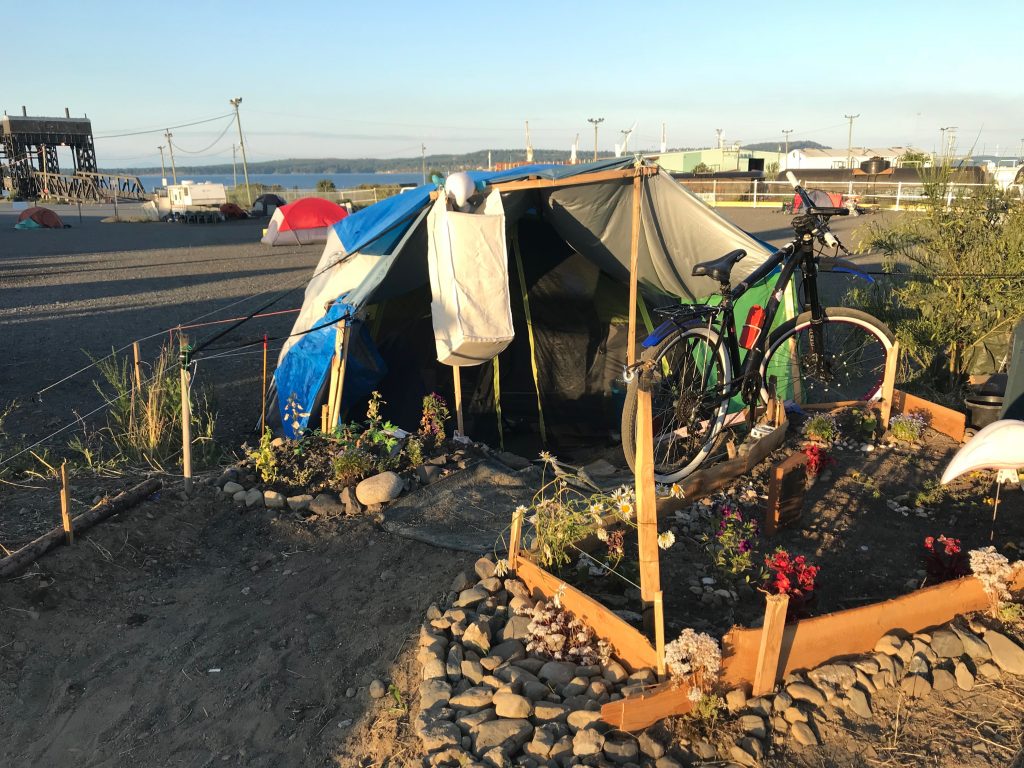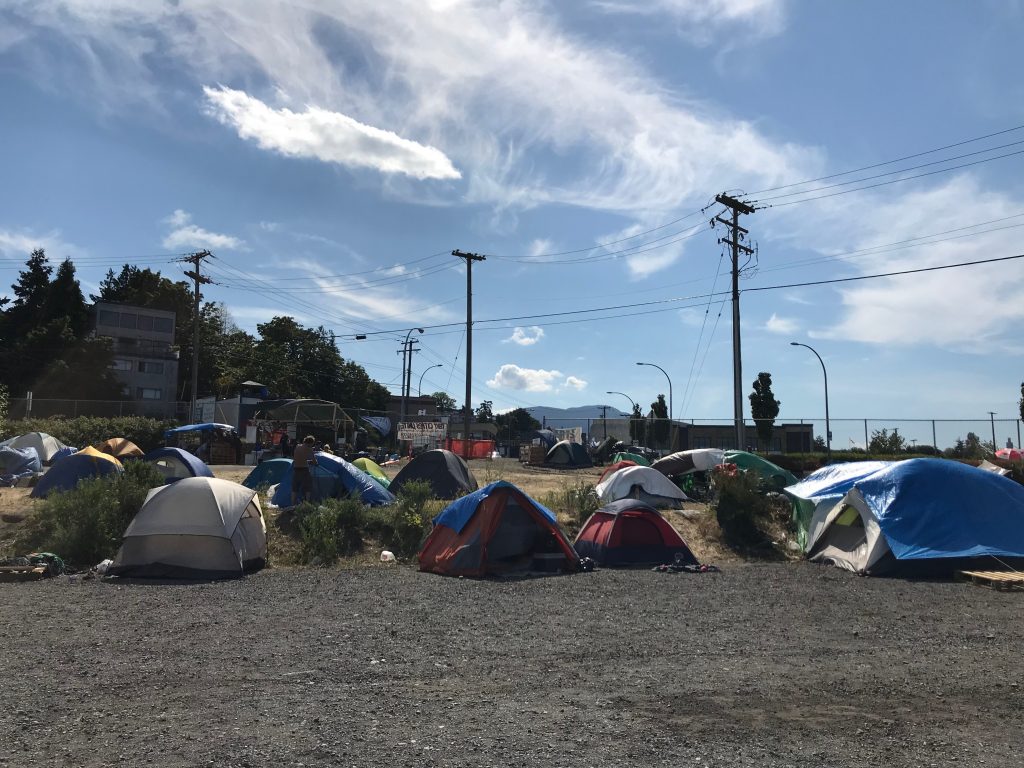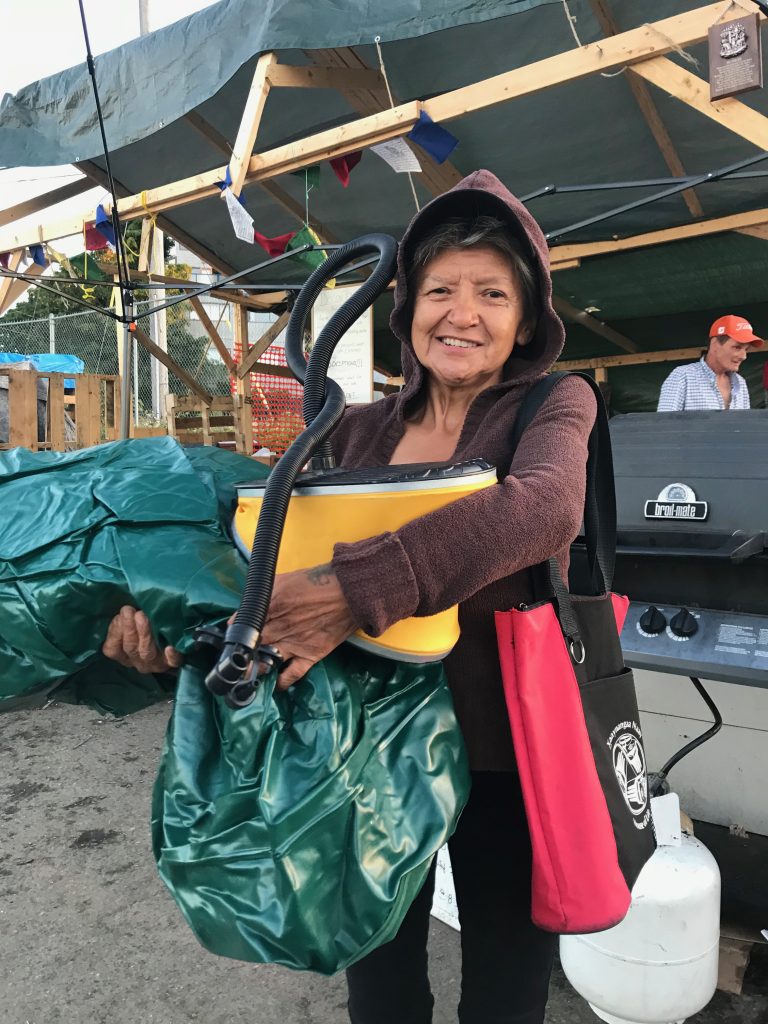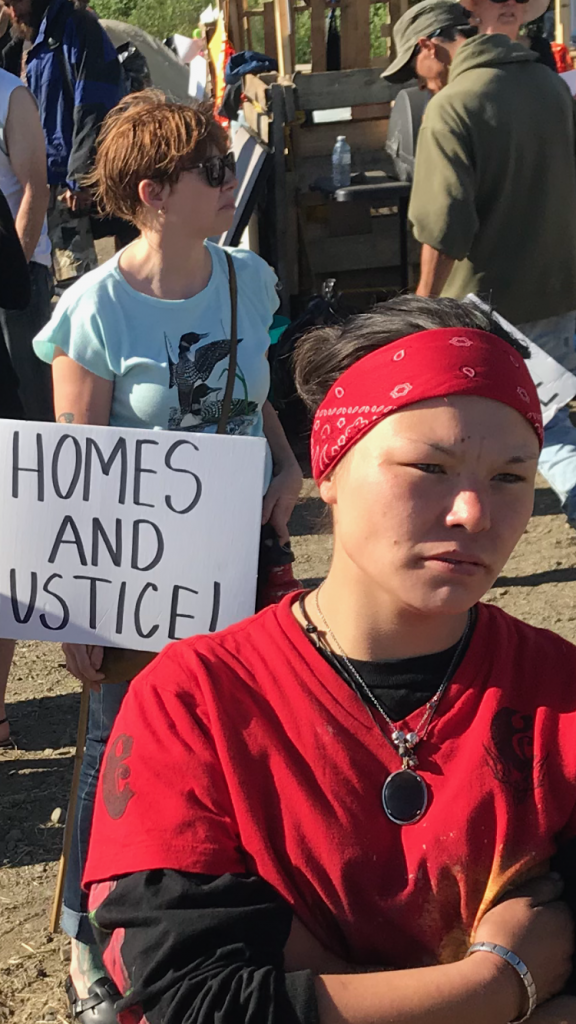
“If they break up this camp they’ll put us back out to get beat on more”
Nanaimo’s injunction against Discontent City seeks to retrench poverty and anti-Indigenous racism

On July 16th, Discontent City will appear in BC Supreme Court to oppose the City of Nanaimo’s application for an injunction to break up the tent city that has so quickly become home to more than 200 homeless people. The City’s arguments for a Court order to displace the camp are typical of government efforts to break up tent cities. The City claims that the camp is a nuisance to surrounding property owners, that its residents are criminals who are increasing crime rates, and that the population of the camp are not “real” homeless people and not “really” from Nanaimo. Against these claims, all of which are without rational or empirical merit, Discontent City will argue that the camp improves the health, safety, and protection of personal property for homeless people and that displacement would cause harm, violating homeless peoples’ Charter rights.
Nanaimo’s Supreme Court injunction application to break up Discontent City is a legal fight and if the City wins then we could see more Cities try to break up camps that have formed under their jurisdiction. But this injunction fight is first and foremost a political fight where the self-organized power of homeless people is tested by the force of Canada’s state apparatus. Without Discontent City – the self-organized, illicit home and base of political activity of homeless people in Nanaimo – the business as usual police and bylaw repression and social worker management of homeless communities would have carried on unchallenged. Nanaimo’s injunction application is the City’s attempt to reassert its violent and arbitrary power over the victims of the housing crisis.

“Born and raised”
The City’s first claim is that homeless people are not “really” from Nanaimo. It is difficult to assemble evidence to counter such a claim because the City could claim that anyone who testifies as a resident of Nanaimo is an exception. I walked around in camp and did a survey of everyone who I could find. I said, “the City claims that people in camp are not really from Nanaimo. Where are you from?” It is frustrating to argue that people are “from here” because, as one man told me, “I’m against answering that question because we have a Charter right to movement in Canada. We can’t give up our Charter right.” Most people, however, wanted to express that this place that hates them is their home. I spoke with 29 people and, without exception, they all felt that Nanaimo is their home.
There was one group that had a story of having moved to Nanaimo more than a decade ago for work, owning a house and having a family, and then losing their jobs and eventually losing their homes and being pushed to the street. One man said, “I moved here 9 years ago from Duncan. I owned a house here with my wife but I lost it.” Another person said, “I’m 54 years old and I have lived here for 35 years. Before that I lived in Victoria and for a few years in Campbell River.” Another man was born in Richmond but has lived in Nanaimo for 7 years. He “bought a condo here after my marriage on the Mainland broke down.” Another man moved to Nanaimo during Expo 86, following work. “I worked for Toyota doing body work,” he said. When the Toyota shop was sold to McLeods he lost his job. Since then, “I have been on the streets a couple years solid – never inside.”
Another group is people who were “born and raised” in Nanaimo. Nine people I spoke with used the words “born and raised” in Nanaimo to describe themselves. One man gestured down the street and said “I grew up just down the street!” Another said, “I was born and raised here. Well, not really raised. I’ve been on my own since I was 13.” An elder, retired man exclaimed, “No one here is from Nanaimo? That’s bullshit. I was born and raised! I was born in 1967. I fished here on boats all my life. I’ve only been outside BC once and I’m 50 years old. Me and my wife drove to Calgary once. But I’ve been all over the ocean off this coast.”
Some explained that they have lived in Nanaimo all their lives and say that the hardest thing for them about tent city is that everyone they grew up with are all living in the camp. They have witnessed their entire generation fall into poverty and homelessness. “We’re all from Nanaimo,” a young man said. “We’re all homeless from here. We shouldn’t be homeless in our hometown.” A young woman said, “There’s a lot of people from Nanaimo in camp. Like people I grew up with here.” A middle-aged couple said, “In the past we had been doing some couchsurfing. What’s sad is that everyone I know is on the street; they’re all here. So this time when we got evicted there weren’t many couches left to crash on.”
Tony, who helped start the camp and set up the kitchen and donations system, said that he feels like he knows people of all walks of life in Nanaimo and is confident of his read that Discontent City is a locals-camp. “To be honest,” he said, “I’d say three-quarters of the people here are part of the community that I personally know long term in Nanaimo.”

Shelter from anti-Indigenous hate
But the strongest rebuttal against the claim that homeless people are not from Nanaimo is the strong presence of Indigenous, particularly Snuneymuxw people who live in the camp. A Snuneymuxw man named Elmer told me, “Nobody is from Nanaimo? I think everyone is! I’m from Nanaimo. I’m 35 years old and I was born and raised here – I’m Snuneymuxw and my mom is Snuneymuxw.” And then he explained why he and his mother are staying in the camp rather than on the streets elsewhere. “I’m staying here with my mom. We’re looking for a place and until we find one we’re here.”
Val Sampson, his 55-year-old mother explained more about why she has sought out shelter in Discontent City with her son. She explained that they lived on the streets of Nanaimo for 8 months and learned that the rest of the city is dangerous for Indigenous homeless people who are threatened by both anti-homeless hate and anti-Native racism.
“I’m part of the Snuneymuxw nation and have lived in Nanaimo and Ladysmith all my life,” she said. “This place here is the safest place I’ve been since I’ve lived on the street. The last place I was staying, my son got attacked. Some strangers thought he had money and they attacked him. They were saying, ‘are you selling? You got money?’ They started hitting him, trying to go through his pockets. I went over and tried to stop them from hitting my son and a guy started punching me in the head.”
Val said that it scared her that no one interfered. “There were something like 20 or 30 middle-class white people standing nearby watching. They were just standing there watching. They didn’t do anything. They were even watching them punching me around.” She said that she thought it was because of racism. “I feel like there is a lot of racism here,” she said. “It wasn’t the first time that white people had stood by and watched me get beaten. Another time near the Ukrainian cold weather shelter, three women jumped me and beat me up. If you’re Native and homeless in Nanaimo it’s bad.”
We were sitting by the kitchen tent and a young blond woman walked by. Val stopped, waved at her, and said, “Hey, I’ve still got those clothes for you if you want them.” The young woman walked over, hugged her, and said, “thank you mom.” Val turned back to me and said, “Here in the camp it is different. There are other people who are in the same position, being on the street. We stick up for each other. Here, if someone attacked me people here would help me.” She gestured in the direction where the young woman had walked off and said, “Everyone here calls me mom. I haven’t lived with people for very long here but it feels like family.” She paused and then said, “If they break up this camp they’ll put us back out to get beat on more.”
Homeless in a housing crisis
Sarah lives in Discontent City with her husband Todd. They were evicted without notice when the slum apartment they were living in was condemned by the Fire Chief. Todd was in the hospital at the time but Sarah was on the street from the moment she was evicted. She says, “I know how to get into maintenance rooms and stay there. I couch surfed with friends. I stayed awake a lot by doing a lot of drugs. I lost a lot of weight.”
Sarah says she is on the street because she’s been failed by shelters, low-income housing, and social services. “I refused to go to the women’s shelter because I had given up trying. I don’t get along with the other women who are in the shelter,” she said. “People say things that sound like it will be good and they don’t follow through. Brenda, a nice lady from social services, said she would put us up in a hotel but none of the hotels would rent to us. The hotels discriminate against us. Social services told me that all I needed was an intent to rent form and they would give us the rent money but no one would give us an intent to rent. And these were horrible hotels too, not nice ones. The Value Lodge wouldn’t look at us at all.”
High rents and low vacancy rates in Nanaimo mean that low-income people have nowhere to go but the street. “The cheap hotels are renting for like $1,000 to $1,400 a month. We could come up with it. I’d give my whole check to have a proper place. I am on disability so I get enough to pay that rent. Then I’d have a toilet and hot water. I always paid rent. Just to be off the street, to have a bathroom and running water, I’d pay all my money to rent. I lived in a house before where all my cheque went to rent and I didn’t care. But then that house burned down.”
Pushed to the street by the housing crisis, Sarah says, “I came to tent city a month ago, as soon as we knew it was here. It’s not that bad here apart from the dirt and not being able to shower or have a toilet. We’re with our dogs. I was there when these guys were born and I’ll be there when they die. My dogs are my children.”
Like other people who live in camp, she says, “If the police broke up the tent city we’d be out on the street hiding in a cubbyhole. If that happened I’d be using more drugs to stay awake again. I’m afraid sleeping out in cubby holes. Then once you’re awake too long you’re flailing around and you look worse and get treated worse. It doesn’t make sense to break up this tent city.”

The tent city fightback
On July 16th the counter-arguments between the conveniences of property and business owners and the public and the lives and wellbeing of homeless people will be made in a courtroom that is relatively sheltered from the winds of anti-homeless hate that condition the discussion in media and politicians chambers. A Supreme Court Judge will decide which side holds the “balance of convenience” in relation to the use of property and Charter-protected rights. In tent city cases the “balance of convenience” is the judge’s decision about whether homeless peoples’ access to publicly owned lands is a greater convenience overall than it is an inconvenience to the public. The Charter of Rights and Freedoms is an important measuring-stick in this decision, but the Charter does not exist outside of a social context of the power relations between homeless people and “the public,” which demands that property rights and the rights of people who the law protects are more important than the rights of all people, homeless or not.
Discontent City exists because low-income and homeless people need it. The camp is a sanctuary for homeless Indigenous people from a racist city, and a shelter for people shut out from housing by poverty and discrimination. But Discontent City is more than an organic part of poverty and homelessness, it is a place of homeless people’s power where those who are attacked, insulted, and dehumanized stand together, defend each other, and fight back.
